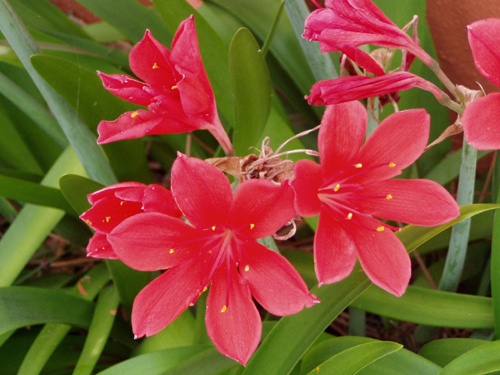More and more people are discovering that growing indoor plants is a very satisfying and rewarding hobby. And because the homes in which we now live are lighter, warmer and more or less draught free, than they used to be, there is less chance of your plants suffering from dramatic changes in temperature throughout the course of the day, or night. So a whole new range of plants from across the world can now be successfully grown indoors. The plants I have selected here are all easy to grow and require just basic care.
Five Plants for a Sunny Position
Callistemon C. Citrinus
Also known as ‘Bottle Brush Plant’. From Australia. This is an easily grown evergreen shrub. Its red spiked flowers appear in June. The flowers have no petals, just spikes, arranged in a Bottle Brush shape. This plant can grow to 4 feet tall. But can be pruned to keep it smaller. They prefer a position which gives them several hours of sunlight every day. However, a cooler position is required in winter, to allow them to rest. Repot after three years growth. Water well in summer but do not allow the pot to stand in water. Keep just moist in winter but never allow the pot to dry out.
Eucalyptus Globulus
This is a fast-growing tree. Because it can grow 3-4 feet a year, it can only be grown indoors for a year or two. It produces sweetly scented glaucous leaves. This is a strong, vigorous growing plant. A seed sown in spring will become a large plant by the end of summer. They prefer a sunny position in a warm or cool room. The plant can be taken out into the garden in summer. When the plant becomes too big, sow a few seeds then discard the plant. Water well in summer allowing the top few inches of the pot to dry out between watering. Keep the pot just moist in winter. Feed with liquid fertilizer every 7-10 days during summer.
Hippeastrum
A flowering plant which grows quickly. It produces large trumpet flowers on 2 feet tall stems. Flowers come in shades of red, white and pink. These are bought as bulbs, some of which are specially prepared to flower at Christmas. One bulb should be placed in a 5 inch pot, leaving half the bulb above the compost. Place the pot in a warm position out of direct sunlight for a few weeks. Water sparingly at first, then increase as growth gets under way. Feed once-a-week as flowers develop. Ordinary bulbs are potted in late winter. Christmas flowering bulbs should be potted in early November. Continue to water until late July, then reduce until the end of September, and finally stop. Keep the bulbs dry until growth begins again in February/March. Repotting every few years.
Sansevieria Trifasciata Laurentii
(Mother-in-law’s Tongue) or sometimes called ‘Good luck plant’. These are a popular and easy to grow plant. Long fleshy, striped leaves, mottled with green and grey. Growth is slow and plants can survive for years. These plants can also become quite tall and top heavy, so a clay pot is recommended. They prefer a warm location with some sunlight, although they are quite adaptable to a range of conditions.
Overwatering can cause problems. Moderate watering in spring and summer. Allow the pot to almost dry out between waterings. In winter, water sparingly, once every two weeks. Feed with a liquid fertilizer, once every two weeks in summer. Roots can be divided in the spring.
Vallota Speciosa
Scarborough Lily is the popular name for this bulbous plant. The long strap-like leaves can grow to 15 inches long. Funnel shaped, bright scarlet flowers appear in August. This plant looks quite striking, in a sunny window. Keep them in a warm position during summer, but rest them in a cooler location over winter. Feed every ten days from late spring to mid-summer. Use a liquid fertilizer, tomato fertilizer is ideal. Water new plants sparingly. More generously as the plant develops. Keep the potting mixture, just moist through winter.
The Author:
David Snowdon is a published writer. He has two main hobbies: Computers and Growing Plants. During his early years, he spent some time working in the Greenhouses of a large Wholesale Plant Nurseries. He is the author of many Computer and Plant growing articles. You can read some of his recent articles, Here. gardenarticles-wolfdave.blogspot.com
